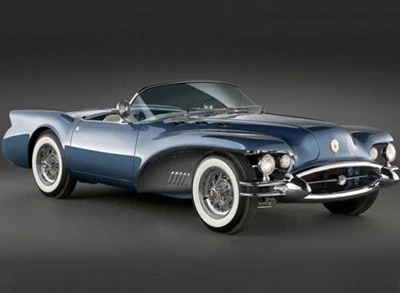The 1950s were the heyday of grassroots fiberglass car design. Unlike Detroit manufacturers who had to produce at mass scale, aspiring car stylists just needed imagination and passion—along with gel coating, molds, and a supply of fiberglass. Enter Noel Bangert and creations like the 1956 Bangert Manta Ray sports car now listed on eBay Motors - opens in new window or tab..

The Buick concept car served as Bangert's inspiration for the Manta Ray.
In his career, Bangert crafted three designs, which were produced and sold as kit cars. The first, introduced in 1954, was the “Stag.” Modeled after Indianapolis race cars, the Stag saw track time at Willow Springs International Raceway and other West Coast venues.
Then he created the Manta Ray, for which he credited the 1954 Buick Wildcat concept car - opens in new window or tab. as inspiration. You can see the influence, especially in the shape of the windshield and the exaggerated front wheel-wells.
The Manta Ray came in two pieces with no provisions for a trunk lid or door panels. The primed fiberglass body, mounting brackets, structural reinforcements and hood lid sold for $395. The front piece was designed to flip forward, allowing easy access to the engine area. The design called for the headlights to be installed in the front grille, but owner-builders had quite a bit of leeway.

The front of the Manta Ray flipped open for easy access to the engine and suspension.
Elwood Cauffman of Whittier, Calif. was the original owner of the model offered on eBay - opens in new window or tab.. He opted to make his own chassis using 2x3 rectangular tubing. For extra parts, he used a 1941 Mercury donor—finishing the car in 1956. (It later took on a short-block Chevy engine.)

As delivered, the fiberglass kit car didn’t have door panels. Riders just hop in.
Fast forward to a couple of years ago when Geoff Hacker, one of the enthusiasts behind Forgotten Fiberglass - opens in new window or tab.—a website dedicated to legendary unusual vehicles—heard about Cauffman’s car. He tracked it down in Texas, where he found it in bad shape. Hacker purchased it with the idea of restoring it to the full glory of Noel Bangert’s original design. The restored car debuted at the 2015 Amelia Island Concours D'Elegance. (Despite some enhancements, the seller kept the three-speed Ford transmission and Cauffman's handmade chassis.)
After producing a third model, Bangert Enterprises closed up shop in 1957. Mr. Bangert might not have been a massively successful car designer, but he continued his creative pursuits. After changing his name to Noel Marshall, he went into the movie business—gaining fame and fortune as the executive producer of the 1973 supernatural horror hit, “The Exorcist.”
Share your feedback
This article is meant to provide general guidance only. Automotive maintenance, repair, upgrade, and installation may depend on vehicle-specifics such as make and model. Always consult your owner's manual, repair guide for specific information for your particular vehicle and consider a licensed auto-care professional's help as well, particularly for advance repairs.
